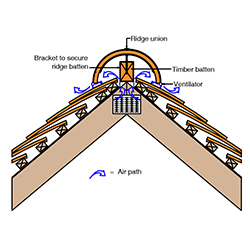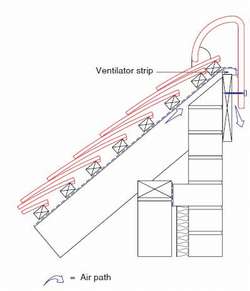Traditionally, ridge tiles are fixed in place with mortar bedding and pointing. Done skillfully with the right motar mix, this method can be successful, however, mortar is susceptible to cracking and falling out, which can lead to ridge tiles becoming loose or dislodged.
To avoid mortar problems, and to include under ridge ventilation to tghe roof space, BS 5534 now requires mechanical fixing of ridge tiles. This is usually achieved with dry fix ridge systems.
While mechanical fixing is the safest method for ridge tile fixing, in some cases, such as heritage buildings, it may not be appropriate. In these cases, BS 8000-6 (Workmanship on construction sites. Slating and Tiling of roofs and walls. Code of practice) does state that traditional mortar bedding (without mechanical fixings) may be acceptable, but this must be carefully planned and agreed by all stakeholders, including insurers, as the fixing of the ridge tiles would no longer be compliant with BS 5534. A compromise may be achieved with the use of mortar and mechanical fixing.
The following illustrations and text explain the common design details using ridges that can occur on refurbishment and new work.
Dry fixed ridge
Ensure dry ridge system is compatible with particular tiles and ridges. Check with manufacturer for advice. Terminate underlay 30mm from apex, or as recommended by manufacturer. If required fix appropriate supplementary ridge batten.
Fix finishing courses of tops tiles maintaining specified headlap and with clearance to ridge batten. Fit dry ridge system and ridge tiles in accordance with Manufacturers Recommendations.
Use stop end or block end ridges at gables.
Bedded ridge
Lay top course of underlay from one side of ridge over apex to overlap top course at other side by not less than 150mm.
Fix finishing courses of tops tiles. Lay ridge tiles by continuously bedding at edges and solidly bedding with tile slips inserted into mortar at joints between ridges.
Optionally, ridge tiles are also screwed to the ridge using drilled or pre-formed screw holes in each ridge tile.
Where masonry walls support or abut ridge, all ridge tiles within 900mm of such walls must be mechanically secured. Fix to supplementary ridge tile fixing batten with nails, clips or wire, etc, as recommended by manufacturer.
Fill ends of ridges at gables with mortar and slips of tiles finished flush.
Bedded monopitch ridge
Carry top course of underlay over apex by not less than 150mm. Fix finishing course of tops tiles. Lay ridge tiles by continuously bedding at sloping edge and solidly bedding with tile slips inserted into mortar at joints between ridges.
Fix vertical face of ridge tiles to ridge fixing batten with screws or nails as recommended by manufacturer.
Fill ends of ridges at gables with mortar and slips of tiles finished flush.
